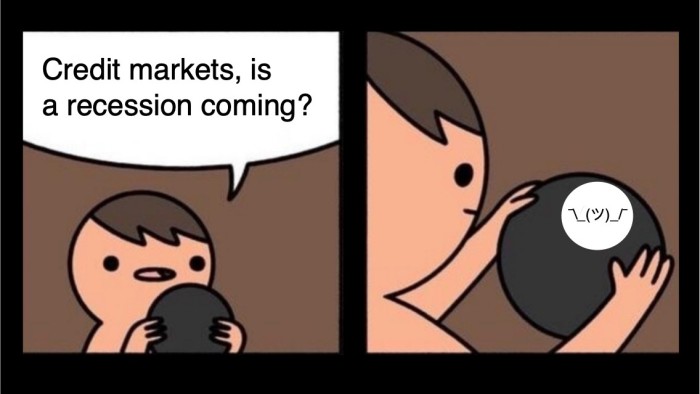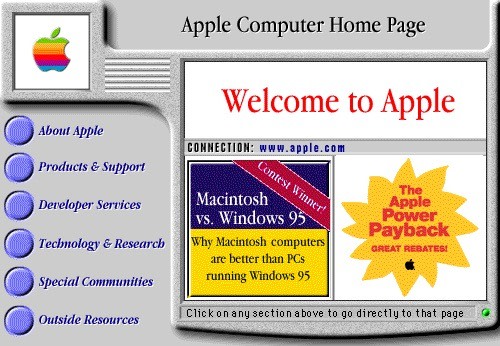FTAV’s further reading
Blog
-

Is credit cruising for a bruising?
Unlock the Editor’s Digest for free
Roula Khalaf, Editor of the FT, selects her favourite stories in this weekly newsletter.
US stocks are queasy, economists are morose, data keeps worsening and even Treasury Secretary Scott Bessent can’t rule out a recession. But one widely followed indicator remains relaxed: high-yield bond spreads.
This matters because credit markets are often seen as more accurate harbingers of economic distress than happy-go-lucky stonks. Junk bond spreads famously sussed out the severity of Covid-19, the global financial crisis, the dotcom bust and the Russian financial crisis of 1998 far earlier than the gormless equity market.
And while credit has certainly taken a hit lately (as we noted yesterday), it has been far more resilient than equities, indicating that credit investors still think a recession is exceptionally unlikely. Here’s what junk bond spreads have done lately.
As you can see, spreads have noticeably widened this year, but at just 325 basis points they are still far below both the near term and long term averages, and the 500-600bps seen at the peak of the 2022-23 growth scare (which in retrospect seems comically overdone).
To put it plainly, these are not levels that indicate that credit investors are unduly worried about a marked uptick in corporate defaults that a recession would entail.
Why then the severe stock market’s wobble? Well, that is easily explainable as a reflection of AI froth abating and tariff drama dampening the upside for many other stocks. Dwindling optimism on earnings is bad for stocks, but can be good for credit if it pushes companies into being more cautious.
Nonetheless, there are a few analysts now arguing that the strength of credit markets should not be over-interpreted. Here’s what Morgan Stanley’s Andrew Sheets wrote yesterday, with his emphasis below:
We’re mindful of the temptation for equity investors to take comfort from the credit market’s resilience. Yet remember, two of the big issues that have faced stocks (the lower chances of animal spirits and heavy concentration in similar names) were not really credit stories. To feel better about those risks, you’ll want to look elsewhere.
What about the risk in the other direction, of credit catching up — or down — to the stock market? This is all about that third factor — growth. If the growth data hold up, credit investors will feel justified in their more modest reaction, as demand and all-in yields remain good.
But if data weaken, the risks to credit grow rapidly, especially as our US economists think that the Fed could struggle to lower interest rates as fast as markets currently expect it to. Credit was much less resilient last week, and EU credit has actually underperformed equities to a pretty large degree. Credit’s ‘resilience’ clearly has limits, especially as growth fears come to the fore.
In other words, credit is less panicky than equities, but it is starting to lose its cool, and if the data keeps weakening then spreads will start to balloon further.
However, there could also be some interesting technical factors at play here. Greg Obenshain of Verdad Capital reckons that the private credit boom might have muffled the signal the credit markets have reliably sent ahead of previous economic downturns.
He points out that the US high yield market has stagnated in size and increased in quality over the past decade, as many riskier corporate borrowers have shifted over to private credit markets. Alphaville’s emphasis below:
The numbers are staggering. While the Bloomberg High-Yield Index has about $1.4 trillion of bonds, it is matched by the leveraged loan market with $1.3 trillion of loans, according to Fitch, and is now exceeded by private credit lenders with as much as $2 trillion of private credit assets, according to McKinsey. While the private credit market has experienced rapid growth in the past ten years, the high-yield market is the same size as it was in 2014.
Furthermore, over the same period, the share of BBs, the highest-rated portion of the index, has climbed from 41% to 51% of the high-yield index. The high-yield market has gotten safer as private markets have removed risky borrowers from high yield and expanded the pool of risky borrowers in the private credit market.
Obenshain still reckons that high yield spreads remain a valuable indicator, pointing out that even über-junky triple-C rated junk bond spreads are still modest even after the recent rise (and that lower-rated debt is not actually a better harbinger).

He argues that, overall, the high yield spread signal is “not broken”, merely a bit different.
It has correctly reflected a positive macroeconomic environment, and so far, it has been right. So where are we now? Spreads are low, and they may be rising. This does not signal an imminent crisis, but it does move us to an environment where equity returns have been lower on average.
Nonetheless, the private credit argument sounds persuasive to Alphaville. You might think it’s just a convenient bogeyman for us, but think about it for minute.
With an average coupon of about 6.4 per cent, the US junk bond market throws off almost $90bn of cash a year, which investors mostly need to reinvest in a market with no net supply for almost decade. It seems very plausible that this technical bid would contain spreads beyond where the fundamentals warrant, even setting aside the shifting credit quality of the market.
And it’s not like the private credit market signal is looking much better . . . .
-

Hunting the hidden hoards of Wall Street
Stay informed with free updates
Simply sign up to the Investment Banking myFT Digest — delivered directly to your inbox.
By now, many people have heard about that guy in Newport who keeps asking the local council to let him excavate their landfill site. He used to have a mining rig in the early days of bitcoin, but had some bad luck and lost his hard drive, so in principle, there are hundreds of millions of dollars’ worth of magic numbers buried among the town’s unrecyclable garbage.
Considering his position helps you understand the labour market for investment bankers at the moment, weirdly enough. They can’t bear to give up on dreams of a buried pot of gold.
It might be considered a bit early to be writing off 2025 – a lot can change in a couple of quarters in the investment banking industry – but a lot has already changed. It’s almost exactly three months since David Solomon of Goldman Sachs said about equity capital markets and M&A revenues, “I think in 2025 we will certainly be at 10-year averages. We might even be ahead of 10-year average”.
Of course, everyone was more optimistic in those halcyon far-gone days of three months ago. Solomon also said, “The first 100 days, obviously, will give us some indication about the balance of whether it’s trade policies, immigration policies, energy policies, tax policies — how the combination of those things will come together”, and in fairness, they have. How desperate are things?
To be honest, not really all that desperate. Global revenues for the year to date aren’t recovering to cycle average levels, but nor are they collapsing. The European and Asian regions have got up off the floor, showing decent percentage growth from a low base, which has more or less offset bad conditions in the USA.
So from the point of view of your average Wall Street CEO, there are really two bad things going on. First, debt capital markets are no longer in boom conditions and so can’t fill in the revenue holes elsewhere (for what it’s worth, for year to date, total global investment banking revenues are tracking down 10 per cent according to Dealogic). And second, the cost base is sized for a recovery, not for another lean year. The banking industry didn’t make layoffs on anything like the usual scale during the 2022 deal drought.
And the reason that the cost-base is oversized is where the resemblance to James Howells and his bitcoins comes in. Everyone knows (or thinks they know) that the conditions of the last two-and-a-half years are revenue postponed, not revenue cancelled. The private equity industry has so much money, so much dry powder waiting on the sidelines, so many exits and acquisitions … wouldn’t it be just the worst thing to cut back your headcount, and then find yourself missing out on another bonanza?
The essence of managing an investment banking franchise is that the biggest driver of success is the capacity to bear pain. Profits are cyclical and transitory, but market share is very persistent; once lost, a client relationship is very difficult and expensive to win back. Goldman Sachs and JPMorgan are at the top of the tree because they have been “long-term greedy” and understood that preserving the franchise is more valuable to shareholders than any year’s dividends or buybacks. Other banks are much further down – and much less profitable in the industry – because they have tried to use cost-cutting to generate stable earnings from a cyclical industry, eroding their client base and tarnishing their reputation as employers, one “shareholder-friendly” move at a time.
Which explains where we are today. The industry is overstaffed, the outlook for bonuses is bad but there are no jobs to go to. And management teams are getting grumpier and bossier. But nobody wants to be the first to give up on the buried treasure. For now. Anything which changes perceptions of the long-term value of the financial sponsors’ fee pool, and its centrality to the investment banks, could be very dangerous to the career prospects of bankers.
Don’t have too much schadenfreude at the private markets crowd – your job is quite likely to be downstream of theirs.
-

And the FTAV chart quiz winner is . . .
Unlock the Editor’s Digest for free
Roula Khalaf, Editor of the FT, selects her favourite stories in this weekly newsletter.
These are unsettling times. The post-WWII international system is fraying, financial markets are quivering and Newcastle has won an actual trophy (a small but real one nonetheless). The latest ominous omen is that I actually managed to get the difficulty setting on a charts quiz roughly right.
Rather than crickets or an inbox-busting, comically large number of correct guesses, we got a healthy number of successful guesses and a lot of soooo close ones. Here’s what last week’s three charts showed:
This is the share price of Blackstone (not BlackRock, as some people guessed).

This shows the price of a dozen Grade-A eggs in the US.
The pink-grey shade shows the overall drop in the S&P 500’s market capitalisation, but we were after the bright-pink bit, which shows the relative contribution of Nvidia’s valuation collapse to the overall carnage.
The last chart tripped up a lot of people who understandably guessed Tesla, but the following champs nailed all three charts: Sam Bevan, Will Moss, Henri de Laromiguière, Ethan Johnston, Michal Hledik, Vlad Tasca, Sam Lee, Jonathan Lipworth and Francisco.
They are all winners of glory, just masses and masses of glory, but only one person can walk away with the prize I❤️charts tee, and the wheel of fortune chose . . .

Congratulations to Jonathan, who never again has to worry about what to wear to flaunt his brainpower in public.
-

Here’s an interesting debt market outlier
Unlock the Editor’s Digest for free
Roula Khalaf, Editor of the FT, selects her favourite stories in this weekly newsletter.
This has not been a good month for markets. Stocks have crapped out and the bond market couldn’t avoid some of the splashes. But some parts have done better than others, and one in particular has held up intriguingly well.
Generally speaking, safer, high-grade debt has held up better than riskier, lower-rated bonds, but nothing has been immune from the financial turbulence. Here’s an overview of the price action, based on a mix of indices and the largest and most liquid ETFs for each bond market segment.
The outlier at the bottom of the table at is PRIV, otherwise known as the SPDR SSGA Apollo IG Public & Private Credit ETF, one of the most talked-about ETF launches of recent years.
It’s an actively managed ETF run by State Street Global Advisors that aims to invest about 80 per cent of its money in investment-grade debt, and 20 per cent in junk-rated or unrated securities.
However, the most interesting aspect is that PRIV aims to hold 10-35 per cent of its assets in untraded private credit instruments sourced by Apollo, with the investment company promising to offer firm intraday bids on everything it puts in.
PRIV only started trading on Feb 27, and since then it has outperformed pretty much every single other corner of the global bond market. The only things we can find that has done better is Treasury bills.
It only manages $55mn as of the end of Thursday, and eyeballing its full holdings it seems PRIV is mostly invested in agency MBS and Treasuries. But there are already a smattering of ISIN-less securities in the portfolio that look like private debt securities, and they’ve mostly marked with a market value above their par value.
The PRIV prospectus doesn’t spend much time on how these private securities are valued, only noting that “here are multiple methods that can be used to value a portfolio holding when market quotations are not
readily available”. An accompanying FAQ doesn’t shed much more light:How are the private securities valued?
In calculating PRIV’s NAV per Share, PRIV’s investments are generally valued using market valuations. A market valuation generally means a valuation (1) obtained from an exchange, a pricing service, or a major market maker (or dealer) or (2) based on a price quotation or other equivalent indication of value supplied by an exchange, a pricing service, or a major market maker (or dealer).
Pursuant to Fund Board approved valuation procedures, the Board has designated SSGA as the valuation designee for PRIV. These procedures address, among other things, (1) determining (a) when market quotations are not readily available or reliable and (b) the methodologies to be used for determining the fair value of investments, and (2) the use and oversight of third-party pricing services for fair valuation.
Every security held by PRIV is reviewed and valued daily as part of its NAV calculation process.
PRIV has kept its market value partly thanks to consistently trading at a slender premium to its net asset value, so it seems traders aren’t enormously worried about this. You can also make a decent argument that ETFs are actually better vehicles for less liquid assets than mutual funds.
However, Alphaville is planning on (belatedly) spending a bit more time thinking through some of the potential issues here, given how PRIV is probably just the starting shot of ETF-ising private markets. Let us know your own thoughts by email or in the comments.
-

RIP quant-father Barr Rosenberg
Who are the true pioneers of quantitative finance? Even for us here at FT Alphaville, it’s a difficult question to answer definitively. But it’s still a fun one to ponder.
Practitioners like John McQuown, Ed Thorpe and William Fouse, as well as theorists such as Harry Markowitz, William Sharpe and Gene Fama, could all be considered canonical quant godfathers. You could even plausibly argue that Benjamin Graham was the first of both worlds. Jim Simons was certainly the most successful, in terms of how much sheer moolah he managed to make from a scientific, systematic approach to investing.
But if you talk to quants of a certain generation, there’s one lesser-known name that still occasionally gets whispered about with near-reverence: Barr Rosenberg. It’s with sadness that Alphaville learned that Rosenberg passed away last month, aged 82.
Quantitative finance is an extremely broad field. Rosenberg was specifically an early mover in what is today often called “factor investing” – the exploitation of weirdly persistent market anomalies – through his founding of Rosenberg Institutional Equity Management in 1985.
However, Rosenberg’s most meaningful legacy was years earlier inventing a more systematic framework for investment risk. In an investment industry that is often loath to change, he proved its usefulness and popularised it through his consultancy Barra. Almost all quants today stand on his shoulders. As one admirer once wrote in the FT: “Many of us use his ideas without even knowing they are from him.”
Rosenberg himself often downplayed his contributions, insisting to the financial historian Peter Bernstein that “I’ve made no major contributions to the literature”. His career ended in scandal, when RIEM had to settle SEC charges that it had covered up one of its investment algorithms going bad.
Rosenberg was fined, banned from the industry for life, and instead became a fulltime yogi and spent his last years teaching Tibetan in California. For the shy, cerebral and gentle Buddhist, the downfall was painful. “It was a difficult time,” recalls Sylvia Gretchen, an old family friend. “Very difficult.”
Nonetheless, the embarrassing end to his financial career doesn’t tarnish his legacy. Barra was later acquired by MSCI, through which Rosenberg’s approach to identifying, categorising and managing risks still underpins swaths of finance. As MSCI’s chair and chief executive Henry Fernandez told Alphaville:
Through his creation of Barra, Barr Rosenberg leaves behind a lasting legacy in the world of quantitative investing. Few have advanced systematic and factor investing more than he did through Barra. His work established a language for asset owners and managers to communicate, setting standards for risk management and portfolio construction. He demonstrated how managing risk and taking calculated risks can uncover opportunities throughout the portfolio construction process. He was truly a pioneer.
The guru
Today, Barr Rosenberg is relatively unknown. But back in he 1970s and 1980s – when people first started to use computers and data processing to solve financial problems — he was an unlikely rock star.
In May 1978, the magazine Institutional Investor put Rosenberg on the cover, depicting him as a cerebral, pink-robed giant with flowers in his hair and posing in the lotus position. Around him tiny men in suits prostrated themselves in admiration.
Inside, the magazine marvelled at “the sheer megavoltage” of Rosenberg’s mind, and described a typical scene from one of the conferences his company Barra arranged for its multiplying clients at Pebble Beach, California.
As Rosenberg speaks, a hush typically falls over the audience. In the manner of sinners, heads are slightly bowed. Eyes are moist and a bit glassy. One can almost hear murmurs of “Amen, Brother” and “Praise the Lord . . . “
Being plugged into Barr is now considered by many managers a sine qua non of a winning marketing pitch. (Nobody these days would ever ask, “Barr who?” Like Cher, he is a one-name celebrity.)
There was little in Rosenberg’s background that would indicate that he would become a one-name financial celebrity. He was born in 1942 to a father who taught Shakespeare at Berkeley and a mother who wrote poetry. He grew up as a precocious only child, enrolling in Berkeley at just 16. But in his junior year he chanced upon economics, and was entranced.
He proved a gifted thinker and mathematician – handy traits for a budding economist. As a senior, Rosenberg was allowed to attend the graduate school’s statistics course, taught by future Nobel laureate Gerard Debreu. He went on to get a masters in mathematical economics at the London School of Economics, and a doctorate from Harvard.
But finance fascinated more than macroeconomics. Uncertainty, risk and how to measure and manage it became Rosenberg’s particular focus. As he later told the New York Times:
I’ve always been interested in rational behavior in the face of risk because of illness in my family, which made me aware of the underlying uncertainties of life, and because of the history of both my grandfathers. One was a missionary, the other was an entrepreneur who went bankrupt several times. It always seemed natural to me to be concerned with the possibility of change and of rational response to very uncertain environments.
After Harvard, he joined faculty of his first alma mater, often called “Berzerkeley” for all the countercultural weirdos it attracted. Culturally, Rosenberg fitted in well, given his Buddhism and interest in original-language Tibetan literature. At work he mostly spent his time building esoteric databases of financial data and deploying the econometric methods he had learned on them, thanks to a prestigious grant from the National Science Foundation.
But when Rosenberg’s efforts to turn an old tugboat into a permanent floating home for him and his wife June proved diabolically expensive, he realised he had to start making a bit more money. So he set himself up as a consultant to the finance industry, with Dean Witter as his first client. It proved the first of many.
Barr’s Bionic Betas
It was a heady time for financial economics. When Harry Markowitz had in 1952 first articulated his Modern Portfolio Theory – a method of how to design an optimal portfolio of stocks – only the US military had computers powerful enough to actually run his equations. But by the 1960s they were becoming more available, leading to a wave of theory testing and experimentation.
Moreover, in 1964 the University of Chicago’s Center for Research in Security Prices had published a fabulous data set on US stock market returns going back to 1926. The data was collected on a magnetic tape that if unreeled would have stretched for more than three miles, and provided the raw fuel for an explosion of research.
The result was the birth of Gene Fama’s Efficient Markets Hypothesis, Fischer Black, Myron Scholes and Robert Merton’s options pricing model, and the “capital asset pricing model” developed by the likes of Bill Sharpe, Jack Treynor and John Lintner. By the early 1970s there was a surge in interest in the implications.
Rosenberg built on all this work, and helped transform it from academic theory and into practical applications. CAPM posited a single market factor that drove returns – denoted as the Greek letter beta in Sharpe’s equations – but Rosenberg suggested that there were actually dozens of different factors that in combination drove stock market movements.
For example, JPMorgan’s share price might ebb and flow with the broader market, but it also moves alongside other banks thanks to sector-specific phenomena like interest rates and regulatory changes. Then there are idiosyncratic factors, such as the skill of the CEO.
By 1974, Rosenberg’s consulting was taking off to such an extent that he founded a business to do it full-time, which he named Barr Rosenberg Associates, or Barra. The 60 or so factors that he had isolated became known as “Barr’s Bionic Betas”, and started proliferating in the investment industry.
Rosenberg’s models were a big leap from the first ones developed by the likes of Markowitz and Sharpe, as Ronald Kahn – head of quantitative research at BlackRock and a former Barra employee – wrote in a book on investment management.
They accurately forecasted risk, an improvement over the one-factor market model. They provided a coherent risk framework for investing, neatly organizing the various places that investors could try to outperform: betting on industries or factors, focusing on idiosyncratic (individual security) returns, or some blend of the two. The factor models simplified the calculations required by Markowitz optimization. Overall, Rosenberg accelerated the adoption of modern portfolio theory and, especially, placed risk at the center of investing.
Peter Bernstein’s book Capital Ideas details how Rosenberg was always focused on “applicability”. They should be useful, not just academically interesting. This practical focus helped attract the likes of the American National Bank in Chicago, Prudential, Wells Fargo, Travelers and the College Retirement Equities Fund as Barra clients by the late 1970s.
This despite what was a phenomenally complicated approach for the time – Barra’s computer programs involved about 100,000 separate instructions, and the manual Rosenberg wrote to help clients was over 1,000 pages long. Barra soon began adding other aspects to its business, such as computer programs that allowed institutional investors to analyse the funds they invested to a far better degree than had ever been possible.
Some clients therefore dubbed Rosenberg “the accountant of risk”. Here’s how Rosenberg later described Barra’s business himself:
Barra provided four core services, all of which were somewhat unprecedented but not surprising in the sense that there was a recognized need for these services.
First, providing an investment risk model that predicted the variances of individual stock returns and covariances between the returns of all individual stocks in formats that allowed calculation of risk exposure for any portfolio of stocks, which might be an existing portfolio or a hypothetical portfolio.
Second, characterizing an existing or hypothetical portfolio in terms of these risk exposures, calculating a portfolio’s overall risk exposure and attributing it to exposures to individual stocks and other factors of return.
Third, providing a portfolio optimization system that could calculate the best solution for updating a portfolio by making buys and sells so as to optimize the trade-off between reward and risk.
Fourth, attributing portfolio investment performance to the operative factors maintained in the model and analyzing historical performance to appraise cumulative results.
Rosenberg’s ruin
Rosenberg’s fall was sudden and shocking to everyone who knew him.
In 1985 Rosenberg co-authored a paper detailing what he called “persuasive evidence of market inefficiency”, which detailed the returns of systematically investing in cheap stocks (and momentum trading) almost a decade before Fama and Ken French’s own landmark paper on the subject.
He then left his own consulting firm to found Rosenberg Institutional Equity Management (Barra was later sold to MSCI in 2004 for $846mn), to put all this into practice. It was a tremendous success, accumulating $9bn of assets in just its first five years, according to Bernstein. In 1998 the insurance group AXA bought a controlling stake for $125mn, and by 2007 AXA Rosenberg managed over $135bn.
However, the financial crisis first shredded the performance of many of its models, leading assets to gush out. Then someone at AXA Rosenberg in June 2009 noticed a problem with one of the investment manager’s risk management models. Rather than fix the mistake immediately, Rosenberg said that it should be corrected as part of the release of an updated risk model scheduled for September 2009, and failed to tell the board or the company’s CEO or CIO about it.
The SEC argued this delay caused $217mn in losses for AXA Rosenberg’s clients, and excoriated Barr Rosenberg in the subsequent enforcement case:
“Rosenberg chose concealment over candor, and in doing so selfishly served his interests over those of his clients,” said Robert Khuzami, Director of the SEC’s Division of Enforcement.
Bruce Karpati, Co-Chief of the Asset Management Unit in the SEC’s Division of Enforcement, added, “Investors in quant funds trust their advisers to develop, maintain and operate the quant models that drive a fund’s performance. Rosenberg betrayed investors when he failed to disclose the material coding error.”
The fizzling performance and the subsequent scandal deflated AXA Rosenberg’s assets to just $20bn. Rosenberg resigned humiliated, and the rump of his company became a wholly owned subsidiary of AXA (which finally killed the Rosenberg brand in 2022).
Some admirers felt Rosenberg had been treated harshly by authorities keen on simply getting scalps in the wake of the financial crisis. The $217mn estimated loss from the coding error calculated by Cornerstone Research was over a two-year period and affected about 600 client portfolios, coming in at about 22 basis points on average annually. It also found that over half of AXA Rosenberg’s clients were either unaffected or actually gained from the additional risk that the faulty model led to.
Nonetheless, having been banned from ever working in finance again, Rosenberg retired to spend the rest of his life at the Nyingma Institute, a Tibetan centre in Berkeley. Even after retiring as co-dean Rosenberg kept teaching there until a month before he passed away in early February.
His wife June passed away a few years ago from cancer, and the Rosenbergs had no children. But Sylvia Gretchen, his co-dean of many years at the Nyingma Institute, says that he leaves a huge legacy among his extensive family of friends there, and will be buried on the grounds. She told Alphaville:
He had a towering intellect, and an ability to work with ideas, put them together in new ways and apply them to practical problems. The way he solved problems was really interesting.
But most of all he was absolutely delightful. He was a very kind person, who really cared about other people . . . He lived a good life, he really did. He did the best he could with the gifts he had, and he was loved. And that’s all he ever wanted out of life.

RIP © Sylvia Gretchen -

Since Trump’s victory, SpaceX is either up 50% or little changed
Unlock the Editor’s Digest for free
Roula Khalaf, Editor of the FT, selects her favourite stories in this weekly newsletter.
Sure, Jan:
Bloomberg (12/3/25) — Shares of Tesla Inc., Elon Musk’s public company, have been in freefall for the last few months. But shares in his private companies aren’t.
Secondary market investors have sent the collective valuation of four of Musk’s private entities up 45% since the US election, according to a new analysis from trading platform Caplight, exclusively shared with Bloomberg.
Musk’s status as world’s richest person rests more with SpaceX than Tesla. He owns 42 per cent of the rocket launcher, which was valued at $350bn by a December tender offer to employees.
Since about three-fifths by value of Musk’s companies are private, estimating his net worth involves a lot of guesswork. Funding round announcements for his start-ups often lack a pre-money valuation, which he prefers to tweet. There’s very little in the public domain about his liabilities and intercompany loans.
Into this void, Caplight applies “aggregated secondary transaction data along with other signals, such as buyer interest”, says Bloomberg. And hoo-boy, these are some signals!
According to the report, SpaceX’s valuation is up 53.9 per cent since the US election! XAI is up 110.1 per cent! Neuralink is up 25.1 per cent!
The problem here is that pre-IPO stock markets are too illiquid to be fit for purpose. Scarcity and novelty puff up the premiums.
For example, SpaceX’s quote on the Forge secondary market stepped higher by 63 per cent on one day in December, long after the employees’ tender offer set a new floor price. For xAI, the quote’s unchanged in the year to date on Forge while on Hiive’s it’s up 94 per cent. These are not efficient markets.
Is there a better way? No.
is there a different way? Yes. Here you go:
The above chart uses the RShares Private-Public Crossover ETF, a fund that bundles together a big lump of SpaceX with a bunch of tech stocks. Morningstar has a great explainer of how that works.
Per the XOVR website, current holdings are:
All the stocks in red are in the Entrepreneur 30 Total Return Index, while those in blue are privately held.
What we’ve done is to normalise both the index and the ETF at the day of the tender offer announcement in December then track the difference on to SpaceX using that day’s $350bn valuation as the starting point.
Our methodology, to be clear, is rubbish. The XOVR ETF only took its current form in August, the amount of SpaceX it holds hasn’t been constant, and there’s a bit of Klarna in there too. We could’ve adjusted for the premium or discount to net asset value but, since it’s in a 1 percentage point range either side of zero, we didn’t bother.
Trying to value the world’s biggest privately held company with an ETF that trades about half a million shares a day is like trying to estimate the size of an elephant’s footprint by what it had for lunch. Nevertheless, as methodology goes, it’s no worse than looking at secondary transactions.
And so, in conclusion, SpaceX’s market readthrough valuation has risen about 2 per cent since the US election. It’s not a very interesting finding, but at least it’s ours.
-

The hidden alpha of corporate websites
Unlock the Editor’s Digest for free
Roula Khalaf, Editor of the FT, selects her favourite stories in this weekly newsletter.
Four decades ago this Saturday, a computer company called Symbolics Inc registered the first ever dotcom internet domain name. It’s still alive today as an online relic, despite the company itself going bankrupt long ago.
If only it had invested more heavily in its pioneering website! At least, that’s the obvious conclusion from a fascinating new report from Wolfe Research’s quantitative analysts.
The team led by Yin Luo scraped the current and historical websites of the almost 800 companies that have been in the S&P 500 since 2013, a chunky 190gb data set of over 85mn individual web pages. They then set to work trying to find out if there any usable investment signals from a company’s web presence.
And lo, there was. FT Alphaville’s emphasis below:
We introduce two sets of stock-selection signals for a total of 64 factors using corporate website data. The first suite of features is primarily based on web meta data, such as the number and size of web pages, broken down into MIME types (e.g., HTML, octetstream, PDF, video). Empirically, companies with informative websites are associated with future outperformance.
Then, we conduct topic modeling on web contents, leveraging our QesBERT finance domain-specific language model. Firms that are leaders in their respective industry, raising unique topics, tend to deliver superior returns in the future.
. . . Finally, we develop a composite stock-selection model, using web meta data and contents. The Wave investable strategy achieves an impressive after-cost Sharpe ratio of 2.1x and a CAGR of 16% since 2020. As the quality of web data improves in recent years, model performance has also markedly advanced.
In other words, the larger, the deeper and the more sophisticated a company’s web presence is, the better its stock does.
This isn’t just a backward-looking thing. The signal derived from Wolfe’s database seems to have strong predictive power. And, rather than fizzling out as differences between corporate websites narrow, it has been getting stronger.
Wolfe’s quants highlight Nvidia as a good example of a company whose evolving web presence has proven a harbinger of good times, rather than just reflecting it.
2013 
2017 
2021 
2025 . . . We can clearly see the focus of Nvidia’s business has transformed greatly, from merely a GPU producer for a small niche market of video game machines to today’s dominance in global AI advancement. A quick glance at its website tells us so much about Nvidia’s transformation. That is the power of conducting historical web analytics for investment.
Of course, this is not an iron law of internet economics. Berkshire Hathaway’s website is famously sparse, and it’s done prrrrettty well over the years. Nor does a website necessarily mean much for investors themselves. Renaissance Technologies’ website is also delightfully dull. And as with every systematic investment signal, this will eventually fade as people exploit it.
However, if there is one site that Alphaville would go sell-our-kidneys-for-OTM-calls long it would be this one, set up by the office of Nintendo’s founding family.
If you haven’t seen it before, do check it out. Words cannot do it justice. But the Yamauchi No. 10 Family Office had a good stab at it:
Seeking stability only clouds your soul. Fear of failing only kills seeds of innovation. We must create a more exciting future where people feel free to dream and leap into a world of possibilities. We must create a freer future where people are eager to truly live . . . We dare to dream. We dare to leap. We dare to live. And we dream that you do too.





